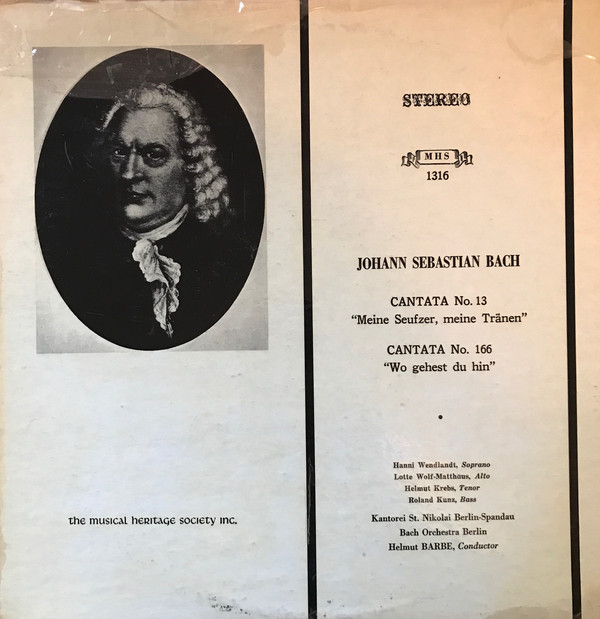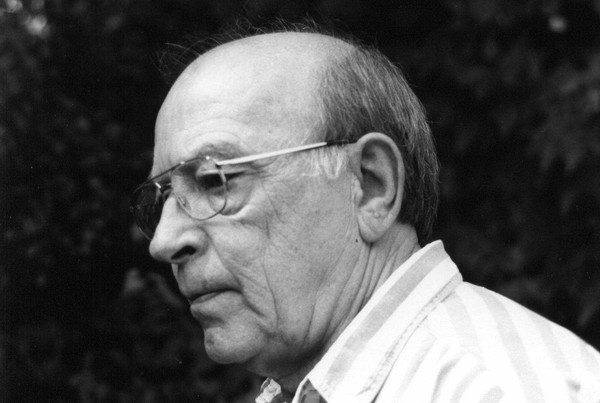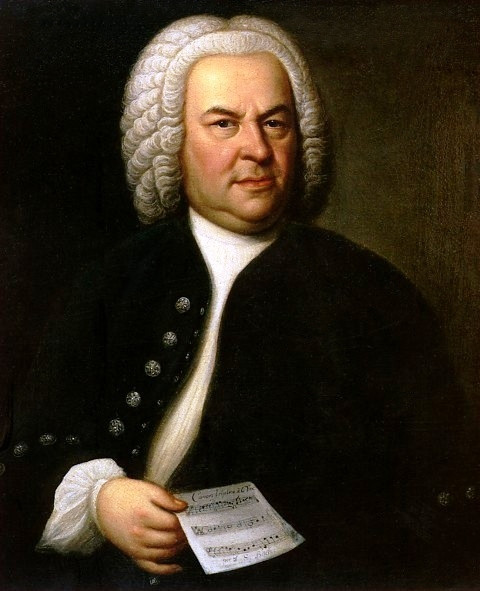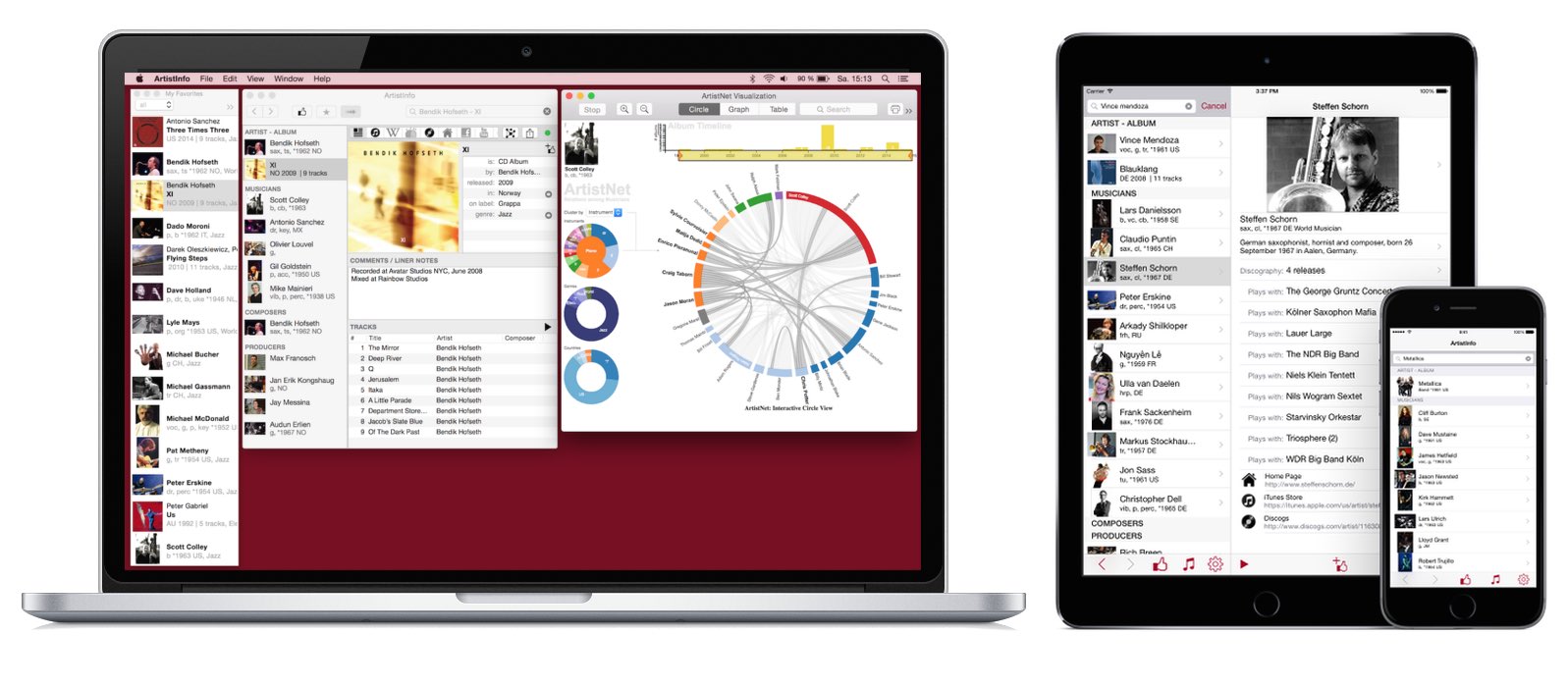
Helmut Barbe, Johann Sebastian Bach, Bach-Orchester Berlin
Cantata No. 13 "Meine Seufzer, meine Tränen" Cantata No. 166 "Wo Gehest du hin"
Album US on Musical Heritage Society, Inc. label
Classical (Baroque)
MHS 1316 MHS 1316 JOHANN SEBASTIAN BACH (1685-1750) Side 1: CANTATA No. 13 for the Second Sunday after Epiphany "Meine Seufzer, meine Tränen" (Lord, my weeping, tears, and sighing) for S.A.T.B. Soli and Chorus, 2 Recorders, Oboe da caccia, Strings and Continuo Side 2: CANTATA No. 166 for the Fourth day of Easter "Wo gehest du hin" (Where goest Thou) for A.T.B. Soli, 4-part Chorus, Oboe, Strings and Continuo Hanni Wendlandt, Soprano Lotte Wolf-Matthaus, Alto Helmut Krebs, Tenor Roland Kunz, Bass Kantorei St. Nikolai Berlin-Spandau Bach Orchestra Berlin Helmut BARBE, Conductor Cantata No. 13 belongs to the third of Bach's extant annual cycle of cantatas, and was first performed on January 20, 1726, the Second Sunday after Epiphany. Its scoring is unusually attractive, for 2 recorders and an oboe da caccia as well as vocal soloists and the usual strings and continuo; the choir appears only in a plain final chorale. The unknown author based his libretto on the Gospel for the day ( John 2, 1-11), concerning the wedding at Cana. Literal references to the Gospel are admittedly rare, though there is one in the second recitative (No. 4): "Gott kann den Wermutsaft gar leicht in Freudenwein werkehren" — "God can e'en worm-wood's gall change into wine of joy and gladness"; but the fundamental idea is drawn from the Bible story: There may at the moment seem no prospect of God's help (cf. John 2, 4: "Mine hour is not yet come"), but I must believe that He will send it. The libretto is clearly divided into two sections, each consisting of three movements and concluding with a chorale verse: the first section with the second verse of Johann Heermann's hymn "Zion klagt mit Angst and Schmerzen"--"Zion suffers from fear and pain" (1636), the second with the last verse of Paul Fleming's "In allen meinen Taten"—"In all my actions" (1641). The two sections are contrasted in subject-matter, the first depicting the hopelessness of those who are apparently deserted by God, the second, the confidence of those who trust in His help. It is doubtful whether the two sections were separated in performance, with the sermon between them; the work seems too short for this. Bach's setting shows that the imagination of a Baroque com-poser was most readily kindled by words referring to sighs and grief. The introductory aria is a long lament. At the beginning, the recorders have the theme; but later the leading role is often transferred to the middle register of the oboe da caccia, producing unusual effects of tone-colour. The form is that of a "strict" da capo aria (ABA), with B subdivided into two sections. Here the voice part obviously depicts "den Weg zum Tode"—"the way to Death," in passages that descend stepwise. The following recitative (No. 2), a short movement accompanied only by continuo, ends with an expressive coloratura on the word "fiehen"—"implore," in the style of a chromatic arioso. The accompaniment of No. 3 is given to the strings; the winds, in unison with the alto, play the unadorned chorale melody. The lively string figuration and the joyful key of F major express faith in the help promised by God, although the words say that there is no sign of help yet. With all its simplicity, the next recitative (No. 4) expresses the words with extraordinary plasticity. It leads on to the second aria of this cantata (No. 5), which is as original as No. 1 in its choice of obbligato instruments — solo violin in unison with both recorders. The words of the first section "Aechzen und erbarmlich Weinen"—"Grieving's vain, and vain repining" are set to a sorrowful tune characterized by the augmented second and its inversion, the diminished seventh, and also by the diminished fifth (in the continuo as well). But a contrast of mood is apparent even in the opening ritornello; the first bars develop the sorrowful motives mentioned above, but later the rapid demisemiquaver passages and skips strike a more cheerful note, which is further developed in the middle section of the aria, to the words "aber wer gen Himmel siehet und rich da um Trost bemiihet . . ."—"he toward heaven who ever reacheth, he from God who comfort seeketh . . .". As in the first aria the way to death is depicted by descending motion, so here the words "gen Himmel"—"toward heaven" are set to an upward leap of an octave in the voice part, and underlined by a rapid rising scale for the obbligato instruments. The aria ends with a free recapitulation of its first section, and is followed by a plain four-part chorale, which concludes the cantata. Cantata No. 166 was composed during Bach's first year of office at Leipzig, and was first performed on May 7, 1724, the Fourth Sunday after Easter. The unknown author of the libretto took as his starting-point the Gospel for the day (John 16, 5-15), where Jesus warns the disciples of his imminent departure, but promises to send them the Holy Ghost. The Gospel begins with the words "But now I go my way to him that sent me; and none of you asketh me, 'Where goest thou?'." The librettist Las taken over the last question, but given it a different and special significance; for whereas in the first movement it can still be understood as a mere quotation from the Bible, in the following aria (No. 2) it appears thus "Detin ich gehe oder stehe, so liegt mid die Frag im Sinn, Mensch, ach Mensch, wo gehst du hin?"—"Every hour and every moment, this the thought that moves me so: Man, 0 Man, where goest thou?". Here the question is put not to Jesus, but to every individual Christian: Is he on the right road? The same thought is followed up in the other movements. A chorale — the third verse of the hymn "Herr Jesu Christ, ich weiss gar wohl"—"Lord Jesus Christ, I know it really," by Bartholomäus Ringwaldt (1582) — prays for true faith, the recitative and aria (Nos. 4 and 5) utter a warning against worldly joys, and the final chorale — the first verse of "Wer Weiss, wie nahe mir mein Ende"—"Nobody knows, how my death approaches,' by Aemilie Juliane von Schwarzburg-Rudolstadt (1688) — refers to the end of our earthly course and asks for God's support. In the first movement Bach stresses the librettist's conception by giving the words "Wo gehest du hin?"—"Where goest thou?" to a bass — the voice of Christ, according to the tradition long since established by settings of the Passion. As a result, one hears in this movement not only a quotation from the Gospel, but a question put by Christ to every member of his flock. The follow-ing aria (No. 2), whose instrumental accompaniment for oboe and violin solo was first reconstructed in the Neue Bach-Ausgabe, is exceptionally beautiful. In its middle section the words "Gehen" —"Stehen"—"walk"—"stand" (in English translation: "Every hour and every moment") are depicted by rising scales and long-held notes respectively. In No. 3 the soprano sings the chorale unornamented, in long notes, against the powerful unison of violins and violas. The movement is thus given a strength that corresponds to the sense of the words. Although the following recitative and aria (Nos. 4 and 5) ex-press a warning against worldly joys, they strike a much more cheerful note. In the aria, whose dance-like character is mistakable, the "shaking" figuration no doubt paints the laughter of good fortune, which is also expressed by the long coloraturas and trills of the voice part. With the casualness of a Baroque composer, Bach here seizes every opportunity of represenling isolated words pictorially, even when their mood is questioned or contradicted by the text as a whole. He thus contrived a contrast of mood between the first and second parts of the cantata, which corresponds to the librettist's contrast between Heaven and Earth. After this dance-like aria, the solemnity of the final chorale is all the more striking, with its prayer: "Machs nu: mit meinem Ende gut!"—"In my last hour be Thou my stay!" ALFRED DUERR Translated by Walter Emery Timings Side 1: 20:33 Side 2: 18:11 Stereo records may be played on modern mono equipment. It is advisable to wipe record with antistatic dust cloth before playing. The Musical Heritage Society Inc. 1991 Broabway, New York, N. Y. 10023 Recorded by CANTATE Library of Congress Catalog Card No. 72-750049
Musicians
 | Helmut Barbe org, *1927 DE album by |
 | Johann Sebastian Bach , 1685-1750 DE album by |
 | Bach-Orchester Berlin , album by |
Album Tracks
| No | Title | Artist | Composer | Duration |
|---|---|---|---|---|
| 1 | Cantata No. 13 "Meine Seufzer, meine Tränen" | Helmut Barbe, Johann Sebastian Bach, Bach-Orchester Berlin | 20:33 | |
| 2 | Cantata No. 166 "Wo gehest du hin" | Helmut Barbe, Johann Sebastian Bach, Bach-Orchester Berlin | 18:11 |
